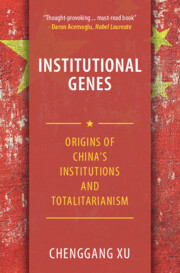Refine search
Actions for selected content:
8 results
1 - Introduction
-
- Book:
- Institutional Genes
- Published online:
- 03 June 2025
- Print publication:
- 26 June 2025, pp 1-58
-
- Chapter
- Export citation
5 - The Imperial Examinations and Confucianism
-
- Book:
- Institutional Genes
- Published online:
- 03 June 2025
- Print publication:
- 26 June 2025, pp 163-201
-
- Chapter
- Export citation
4 - The Emergence and Evolution of the Institutional Genes of the Chinese Imperial System
-
- Book:
- Institutional Genes
- Published online:
- 03 June 2025
- Print publication:
- 26 June 2025, pp 122-162
-
- Chapter
- Export citation
2 - Institutions and Institutional Genes
-
- Book:
- Institutional Genes
- Published online:
- 03 June 2025
- Print publication:
- 26 June 2025, pp 59-90
-
- Chapter
- Export citation
14 - Conclusion
-
- Book:
- Institutional Genes
- Published online:
- 03 June 2025
- Print publication:
- 26 June 2025, pp 658-724
-
- Chapter
- Export citation
3 - Property Rights as a Form of Institutional Gene
-
- Book:
- Institutional Genes
- Published online:
- 03 June 2025
- Print publication:
- 26 June 2025, pp 91-121
-
- Chapter
- Export citation

Institutional Genes
- Origins of China's Institutions and Totalitarianism
-
- Published online:
- 03 June 2025
- Print publication:
- 26 June 2025
15 - The Origin of China’s Communist Institutions
- from Part II - 1950 to the Present
-
-
- Book:
- The Cambridge Economic History of China
- Published online:
- 07 February 2022
- Print publication:
- 24 February 2022, pp 531-564
-
- Chapter
- Export citation
